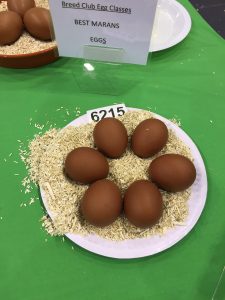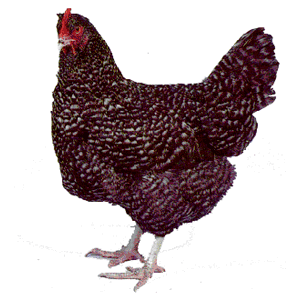
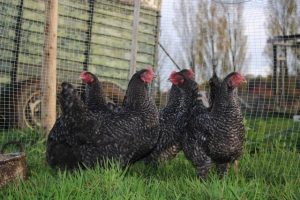
Breed Overview
Maran chickens take their name from the small port of Marans, situated on the Atlantic coast of France in the Charente Maritime departement. In the late 19th Century Langshan Chickens were imported from Asia into the Marans area of France and bred with local game type birds. This breeding produced the ‘Maran’ dual purpose (eggs & meat) chicken that laid good quantities of large dark brown eggs. Marans were imported into the UK and USA in the 1930s.
Their original make-up included strains from Cuckoo des Malines, Faverolles, Rennes, Braekel, Galtinaise, Barred Plymouth Rock and Croad Langshan. The French strain of Marans had feathered legs, but the English and American strains usually have non feathered legs – usually slate or white in color.
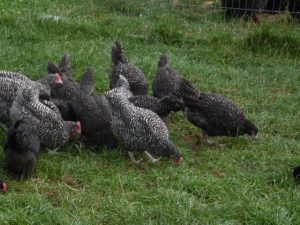
Marans are quiet and docile chickens, sometimes described as ‘lazy’, but best known as regular layers of very large brown eggs. The Cuckoo is the most common colour, hence the Cuckoo Maran is the most widely kept variety of Maran. No commercial breed of chicken can come anywhere close to the unusual dark brown egg color, which is highly sought after for its color, size and taste.
Weight & Info
Marans are available as standard size and bantam size birds. Standard size cocks weigh 8.5 lbs (3.8 kg) and standard hens 7 lbs (3.1 kg). Bantam cocks weigh 2.3 lbs (1.1 kg) and Bantam hens 2 lbs (0.9 kg)
These birds can fly off quickly if threatened, with the Bantams often trying to fly more than Standard Chickens. High protective fencing is necessary to keep predators at bay.
Marans are suitable for dual egg and meat production, but are mostly kept by backyard chicken enthusiasts for their easy to manage behaviour and high numbers of large brown eggs.
In the UK it is easy to find pure bred Maran chickens for sale, particularly the Cuckoo Maran and Copper Black birds. There are also many cross-breeds of Marans available.
Eggs
Maran eggs are large in size, varying in color from brown to dark chocolate, usually with vibrant colored yolks if the birds are well fed and cared for. See my picture below:
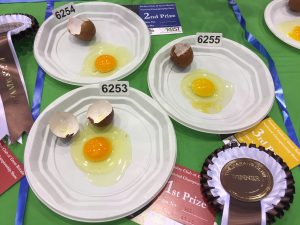
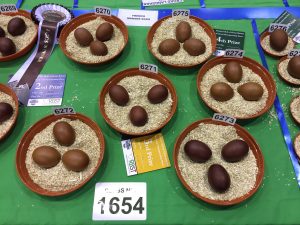
Color
Eggs are usually dark brown, sometimes with speckles
Egg production per year
170 to 190 eggs per year
When do they start laying eggs?
From 5 to 6 months
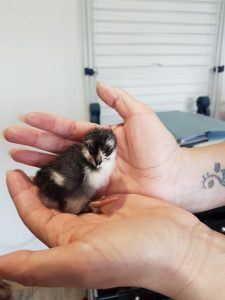
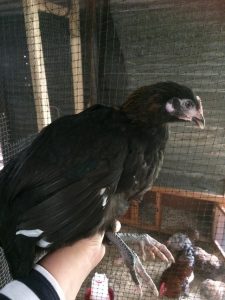
Maran Characteristics
Temperament / Are they good as pets
Maran hens are fairly docile, very friendly and considered to be good mothers, generally getting along quite well together. One cockerel for around 8 hens is a good ratio and Maran cockerels are noted for being unaggressive, unless protecting their ‘flock’. These are a good ‘starter’ chicken for backyard enthusiasts, as they are calm and easy to look after. Marans are considered to be intelligent birds, but can become lazy and run to fat easily if not encouraged to forage regularly.
As with any animal, children need to treat Marans with respect, always under adult supervision. Gentle handling from chick stage quickly gets them used to human contact. Regular worming and dusting for mites is required, along with frequent cleaning of chicken confinement areas. Marans can live up to 8 years.
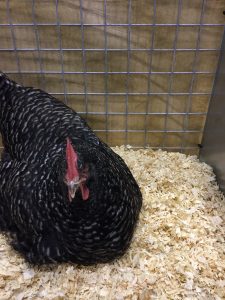
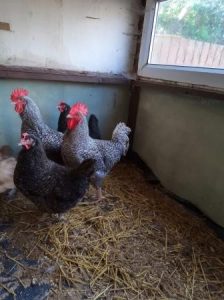
How do I tame Maran chickens?
The best way to tame a chicken is to handle it when it is still young; this gets your chickens used to people. If you have older chickens that need taming, try feeding them out of your hand regularly. Marans can become very tame due to their calm and unruffled temperament.
How many do I need to buy?
2 chickens are the absolute minimum you need for a flock, we recommend around 6 as a small flock number, plus a cockerel.
How much space do they need?
Standard sized Marans are quite large birds, but don’t mind being confined in chicken coops for short periods, so ideally 4 square feet minimum per mature bird in a coop. In a run around 20 square feet minimum per bird, with good outside access to prevent boredom. Marans love being outside exploring and foraging for food. Luckily Marans don’t fly much, unless in danger. Marans prefer a roosting perch height of between 2 and 4 feet off the ground, ideally with a pole about 1.5 inches (3.8 cms) thick in diameter.
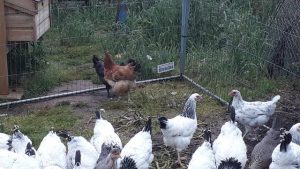
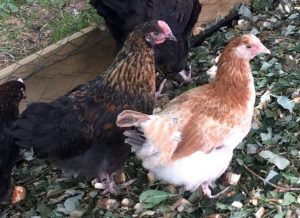
Will they mix with my other chickens?
In general Marans are not at all aggressive. They will get along well with other breeds of chickens, as long as there is no other breed of aggressive male cockerel, which might cause defensive or protective behavior.
Marans will tolerate confinement for short periods, if there is adequate room to explore and prevent boredom. These birds ideally prefer being outside foraging from dawn to dusk, weather permitting. Outside foraging for long hours also keeps Marans fit and well exercised, prolonging their lives and improving egg laying ability. Marans are quite well insulated by their plumage and can tolerate short periods of extreme cold and excessive summer heat (if adequate shade and cool water is available), but prefer a mild climate to thrive.
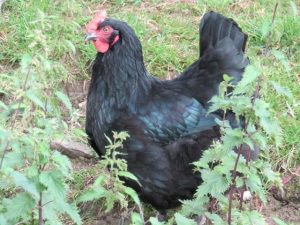
Appearance
Plumage covers the whole body, with short, hard feathers which can vary greatly in color from black, brown, red, blue/green, gray, ginger to white. Plumage has no fluff or down and the tail is usually fairly short and upright. Recognised colors are: Black Tailed Buff, Cuckoo, Golden Cuckoo, Columbian, Black Copper, Wheaten, Birchen, Black, White. Marans have orange red eyes and white ‘horn’ colored short beaks, with white or slate legs. The flesh is white, as are the soles of the feet. The wings are fairly short, but good for short flights and the bird has a slender upright neck.
Marans have a bright red single comb, with five or sometimes six points. The comb is carried upright; the red wattles and red ear lobes are fairly long and prominent.
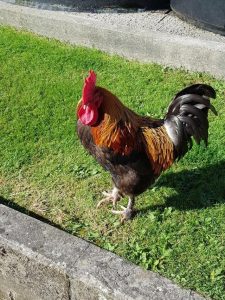
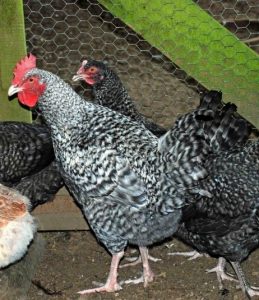
Feeding
What should I feed them?
When you first get your chickens home you should feed them growers mash, as it has a higher percentage of protein (19%) and is refined so that it can be easily ingested. You should feed them growers mash up until 6 weeks where they should be fed chicken pellets which is just feed in pellet form, this has between 15-16% protein. At 18 weeks your chickens need more nutrients to help with egg production so slowly start feeding them layers mash or pellets which has around 16% protein.
Chickens will need access to fresh drinking water all day long, they will prefer cool drinking water, no one is quite sure why maybe it’s a prehistoric throwback. It is important to have the feed and water at the proper height for all birds in the pen. Ideally feed and water should be at back level. If the water is too low down, Marans may scratch litter into it and the water will go bad quickly. Your chickens also need grit to help with egg production, so make sure there is always some within easy access for them at all times.
How much should I feed them?
Marans are hungry birds and will eat anywhere between 5.0 oz (140g) and 7 oz (198g) a day, but on average breeders feed their chickens 6 oz (170g) a day. Start by feeding them this and then adjust the weight of feed around how much they consume. You can leave the feed in a feeder for them to eat whenever they please or you can give them set meal times. Marans love to forage outside for grubs, seeds and bugs, which will provide a substantial part of their diet in some months.
Your chickens also need grit to help with egg production, so make sure there is always some in easy reach for them at all times.
What can’t they eat?
Chocolate and beans are the two main foods that shouldn’t be eaten by chickens. The phytohemagglutinin in beans can lead to fatalities and the theobromine in chocolate can cause heart problems. Moldy food that has bad bacteria in it should not be fed to chickens as it can make them very unwell. For this reason, it is illegal to feed your chickens leftovers in the UK.
What do I need to keep chickens?
The most essential item you need to keep chickens is a coop. This should ideally be 0.4 m2 or 4 square feet per chicken. Their run needs 20 square feet per chicken. In the coop they should have a perch to sleep on and a wooden laying box for their eggs.
You should invest in a sunken fence to go over and around the coop to keep them safe at night. Find a water bowl which they can’t stand in or push over. Place it in the shade, so the water doesn’t get too warm. Feed and water for Marans are best placed off the ground, at around the ‘back’ height of the bird. Raised feed and water bowl holders are easily obtained.
F.A.Q’s
What is a cuckoo maran chicken?
A rare chicken of french origin, known for its egg color. They are very popular as they are hardy birds that lay good numbers of eggs.
Are Cuckoo Marans good layers?
They are classed as fair layers. Females will lay upto 200 eggs per annum. That’s about half a dozen [6] a week.
Do cuckoo marans lay dark eggs?
Yes. Cuckoo Marans are layers of very large dark brown, ‘chocolatey’ looking eggs. Sometimes they are speckled too.
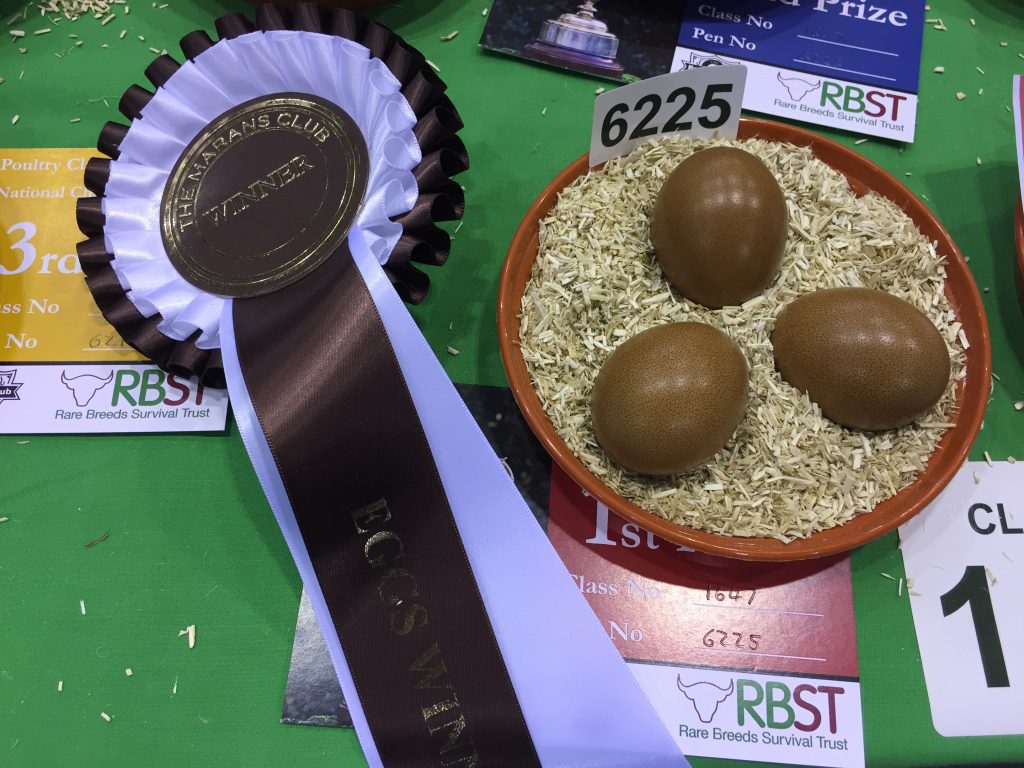
Are Marans cold hardy?
Yes they are a hardy breed. Especially cold hardy, so great if you live a cold more harsher environment.

